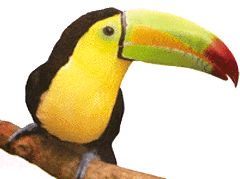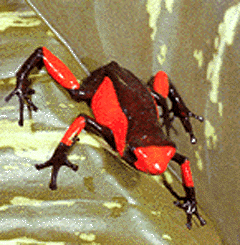
Luxury
Rain Forest
The tropical rainforst contains many species of animal life as it has a huge diversity of animals. Common characteristics found among mammals, birds, reptiles, and amphibians include adaptations to a life in the trees. Other characteristics are bright colors and sharp patterns, loud vocalizations, and diets heavy on fruits. Insects make up the largest single group of animals that live in tropical forests. They include brightly colored butterflies, mosquitoes, camouflaged stick insects, and huge colonies of ants.
AnimalsTitle. click

Sloths are found in canopies of the rainforest. There are two species of sloths: two-toed and three-toed. Most sloths are about the size of a small dog and they have short, flat heads. Their huge hooked claws and long arms allow them to spend most of their time hanging upside-down from trees. Some sloths stay in the same tree for years.

Spider monkeys are large in size. Spider monkeys like to hang upside-down with all four limbs and the tail holding on to branches which makes them look like a spider and thus their name. They spend most of their time high up in the canopy where they can find fruits and seeds to eat. They also eat plants.

There are about 40 different kinds of toucans. Toucans are found in South and Central America in the canopy layer of the rainforest. A toucan's bill is sharp and has saw-like edges. The bill is used to squash the many kinds of fruit and berries he eats. The toucan is very important to the rainforest because they help to disperse seeds from the fruits and berries they eat.

Poison-arrow frogs are found in Central and South America. They are known by their bright colors which warn other animals that they are poisonous. Its poison is one of the most powerful known and can cause paralysis or death. It is so potent that one millionth of an ounce can kill a dog and an amount smaller than a grain of salt can kill a human. Poison-arrow frogs are about the size of a man's thumbnail (less than one inch). The tiny frogs lay their eggs on leaves. When the tadpole hatches, it is carried on one of the parents' back to a bromeliad where the parents feed it small insects, ants, spiders, crustaceans, and tiny water animals

Macaws are the largest of all parrots. There are 16 different species of macaws and they range in size from a little over three feet to one foot. They have long, pointed wings that enable them to fly swiftly. Macaws also have sharp, hooked bills which are perfect for eating nuts, fruits, and seeds. The beak is strong and is used to break open nut pods. Their feet have a very strong grip which allow them to grasp easily. Two of their toes point forward and two point backward. They can use their foot to grasp food and bring it to their mouth. Macaws are very social and intelligent animals. They can be found in Central and South America in the canopy and emergent layers of the rainforest. They like to nest in holes in trees. Macaws are on the endangered species list because their numbers are declining due to rainforest destruction and people capturing them for pets.